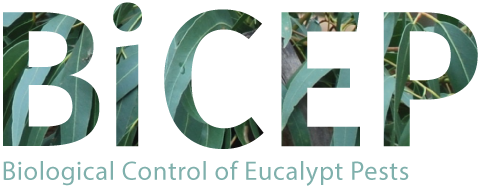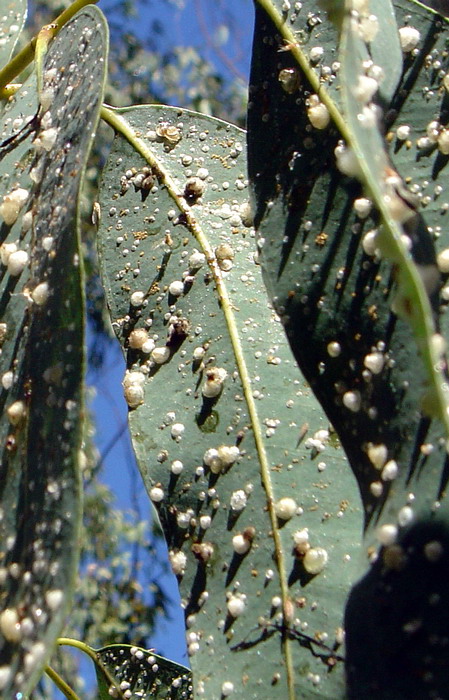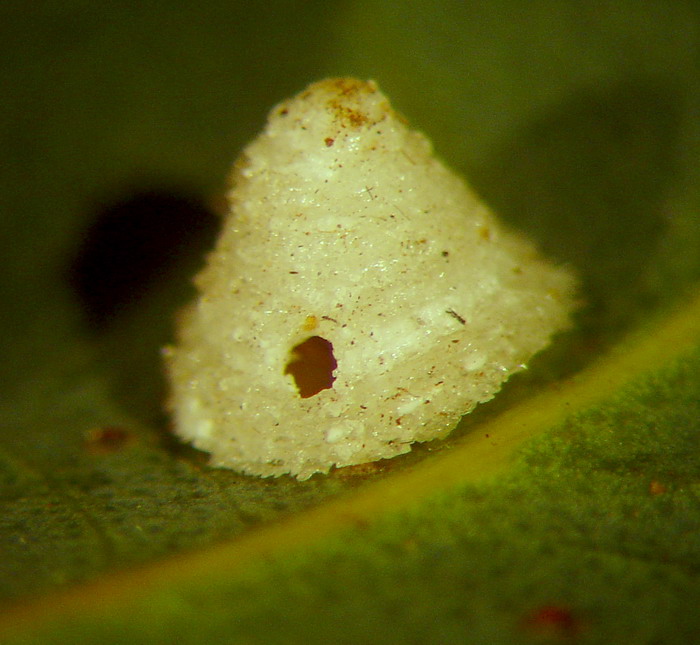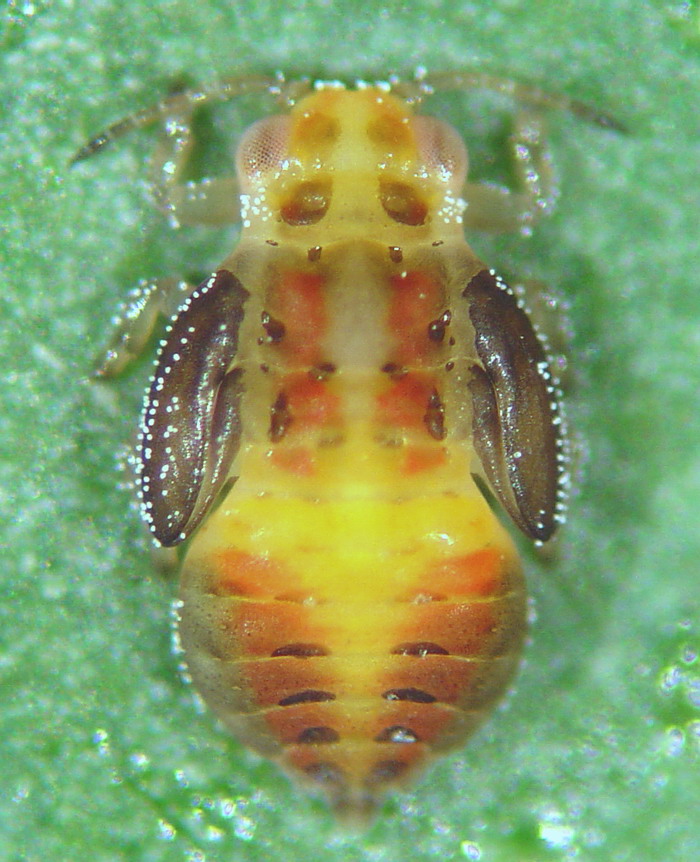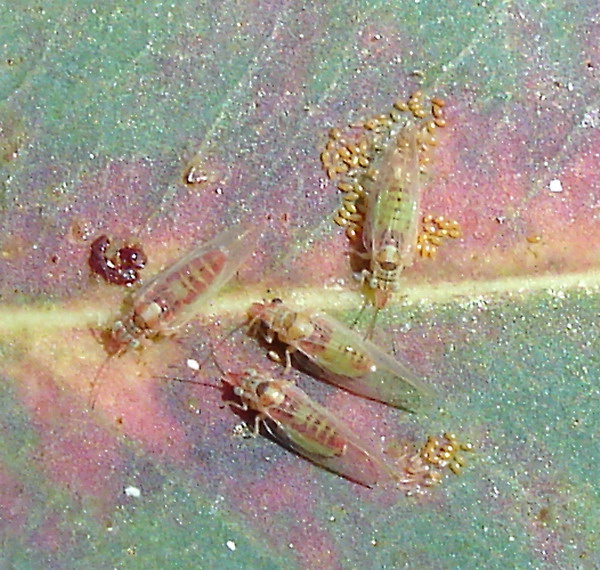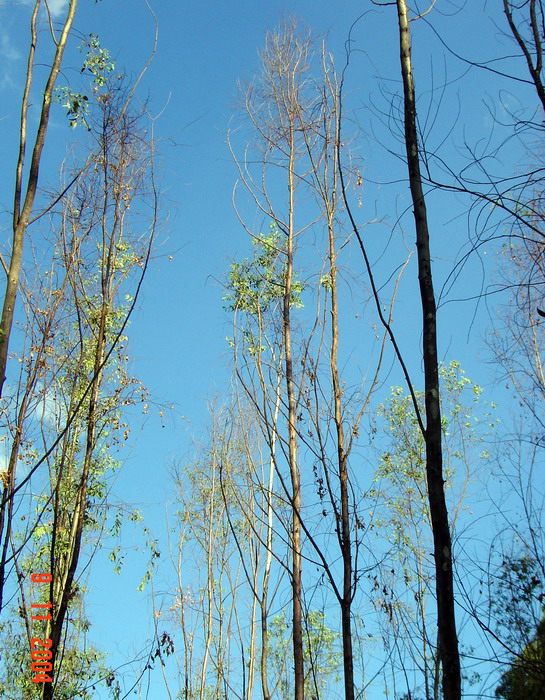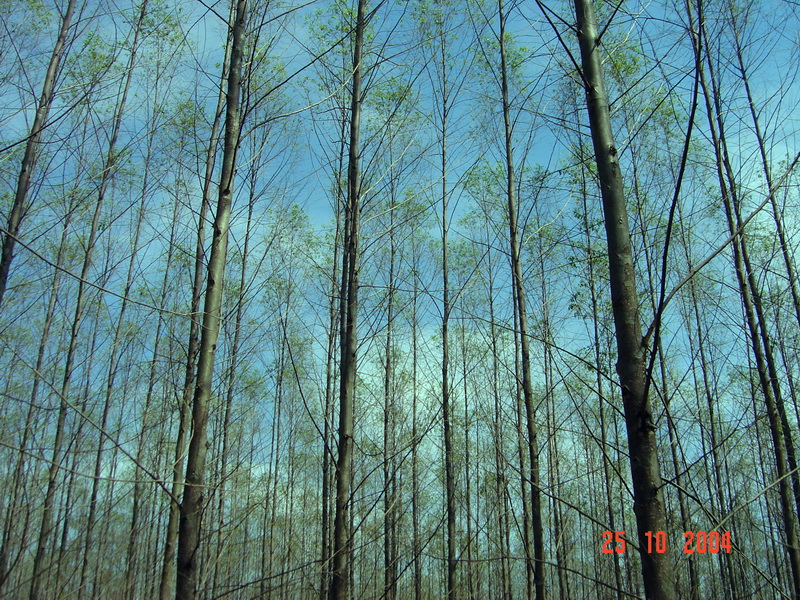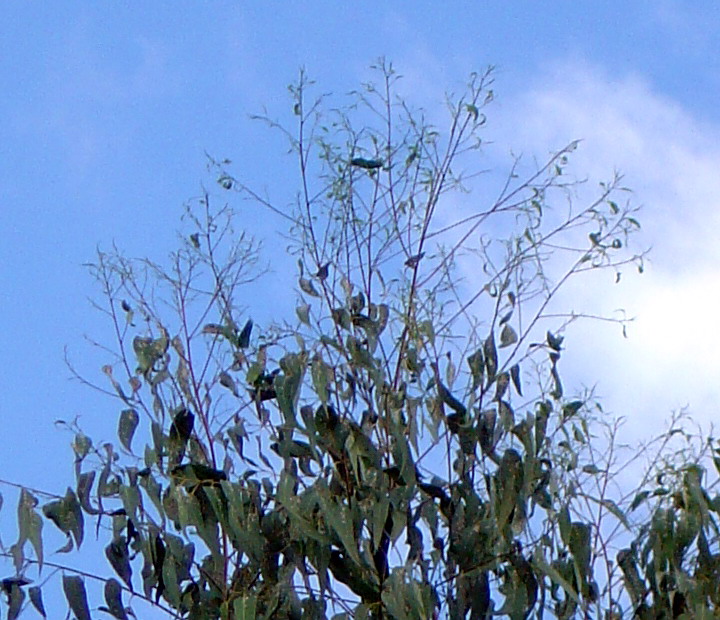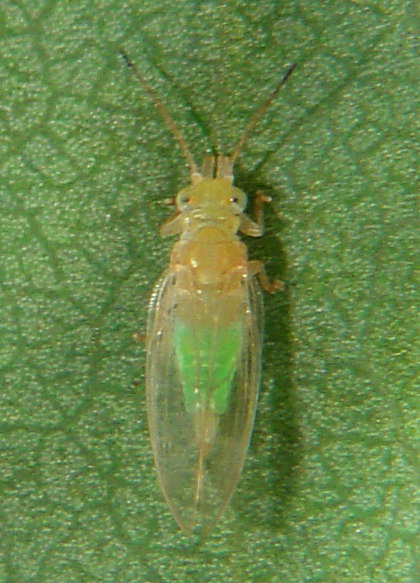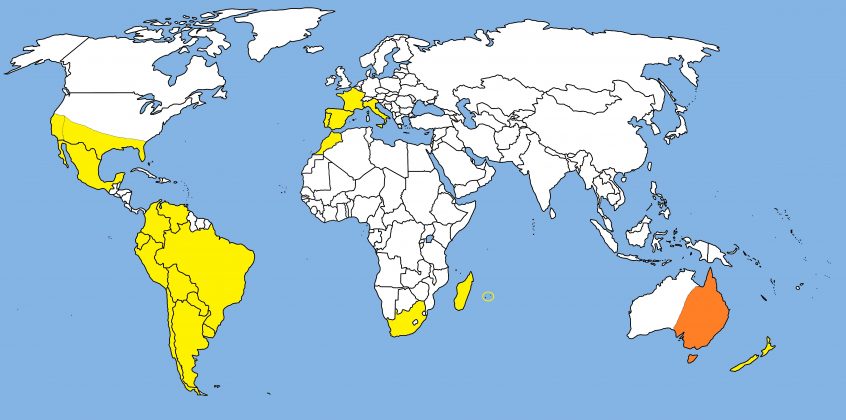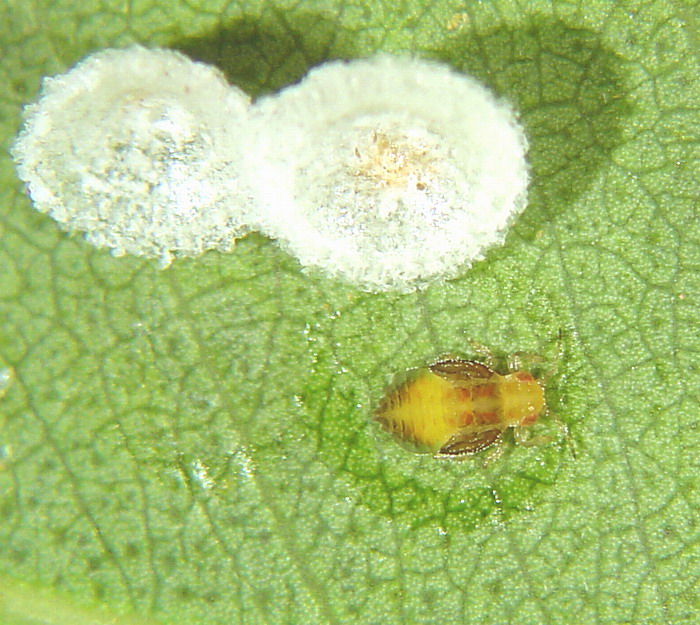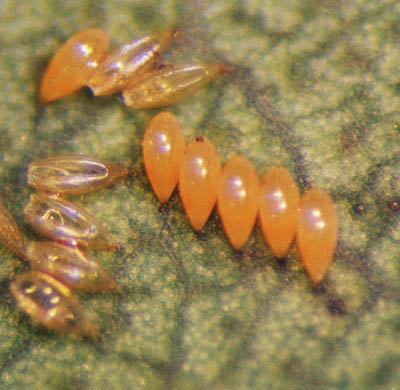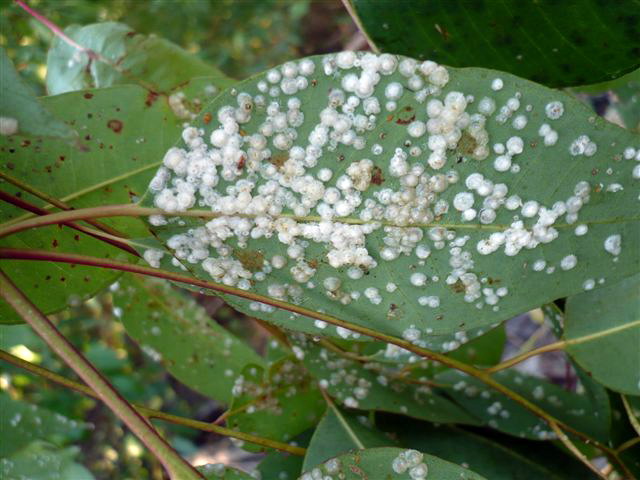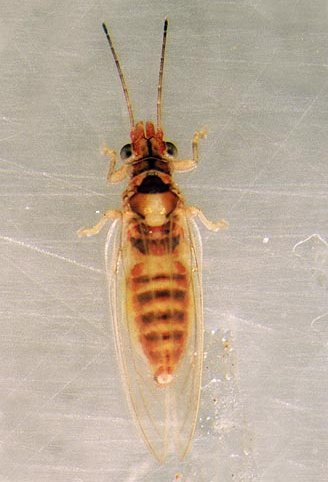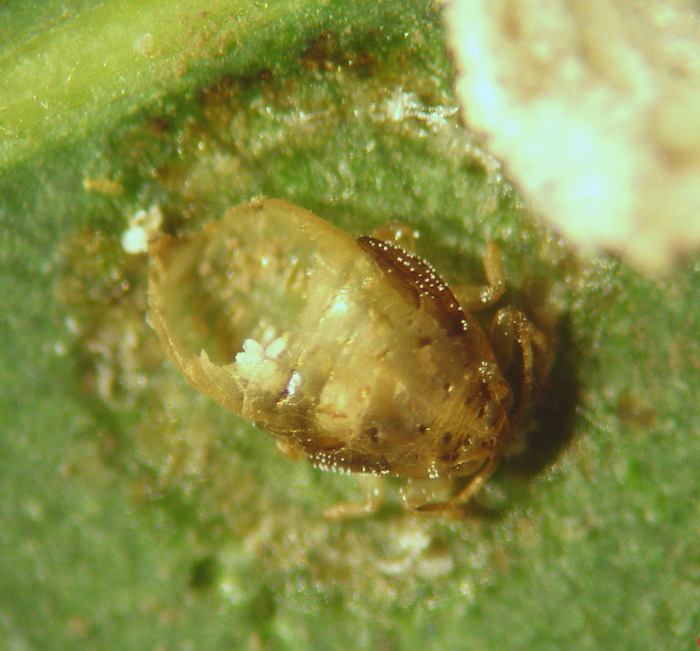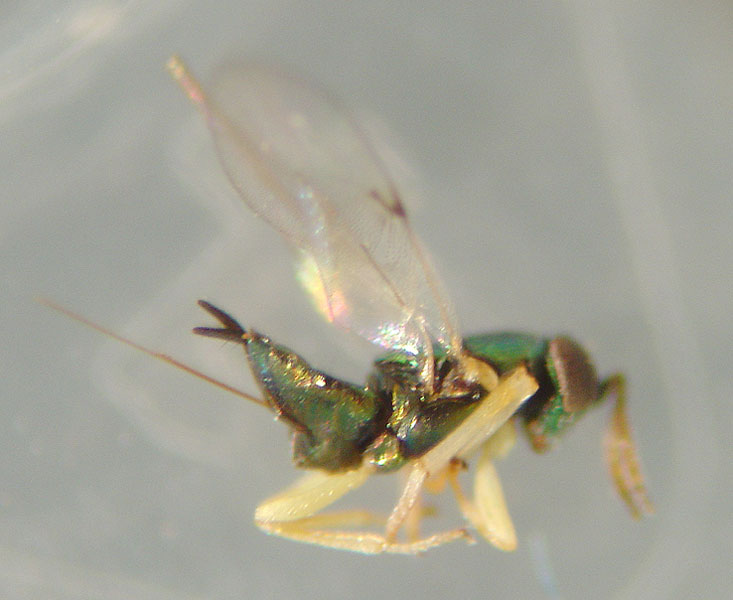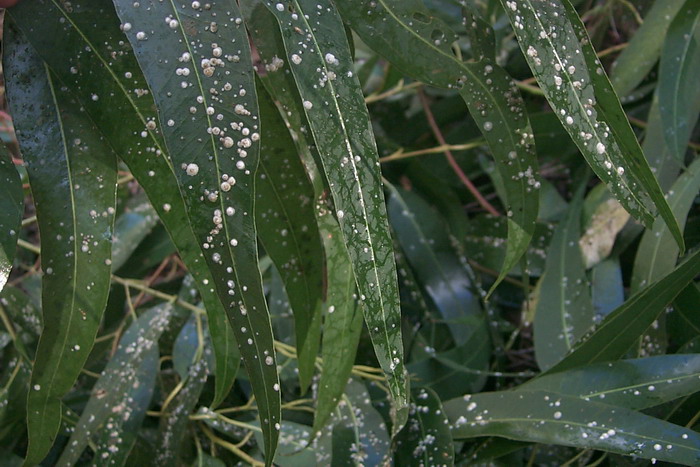Glycaspis brimblecombei
Glycaspis brimblecombei
This Australian species is not considered to be a pest at home but it has become a serious pest of eucalypts in many countries where it has been introduced.
The red gum lerp psyllid Glycaspis brimblecombei Moore (Hemiptera: Psyllidae) is a small (2.5 – 3.1 mm) sap-sucking insect that has distinct adult and nymphal stages. The nymph has a flattened body and is covered by a white conical shelter of wax and sugar (the ‘lerp’) and feeds on leaves concealed under this cover. Adults have wings and can disperse widely.
This Australian species is not considered to be a pest at home but it has become a serious pest of eucalypts in many countries where it has been introduced.
The red gum lerp psyllid Glycaspis brimblecombei Moore (Hemiptera: Psyllidae) is a small (2.5 – 3.1 mm) sap-sucking insect that has distinct adult and nymphal stages. The nymph has a flattened body and is covered by a white conical shelter of wax and sugar (the ‘lerp’) and feeds on leaves concealed under this cover. Adults have wings and can disperse widely.
Host Range
G. brimblecombeifeeds mainly on Eucalyptusspp. in the Section Exsertaria in Australia (e.g. E. camaldulensis, E. tereticornis, E. rudis, E. brassiana, etc.) but it is also found feeding on other taxa outside Australia, including E. urophylla, E. grandis and some hybrids such as E. grandis x E. camaldulensis and E. grandis x E. urophylla.
Host Range
G. brimblecombeifeeds mainly on Eucalyptusspp. in the Section Exsertaria in Australia (e.g. E. camaldulensis, E. tereticornis, E. rudis, E. brassiana, etc.) but it is also found feeding on other taxa outside Australia, including E. urophylla, E. grandis and some hybrids such as E. grandis x E. camaldulensis and E. grandis x E. urophylla.
Damage
The pest causes leaf discolouration, severe defoliation, eventually leading to dieback and can significantly reduce tree growth. In some stands of E. camaldulensis in Brazil it was observed to cause 40 to 95 % tree mortality following three consecutive years of infestations.
Damage
The pest causes leaf discolouration, severe defoliation, eventually leading to dieback and can significantly reduce tree growth. In some stands of E. camaldulensis in Brazil it was observed to cause 40 to 95 % tree mortality following three consecutive years of infestations.
Distribution
At present, this pest is distributed in 20 countries over four continents (excluding Asia). In South America, G. brimblecombei spread to ten countries in only eight years after its first detection. It has most recently been found in South Africa (2012).
Distribution
At present, this pest is distributed in 20 countries over four continents (excluding Asia). In South America, G. brimblecombei spread to ten countries in only eight years after its first detection. It has most recently been found in South Africa (2012).
Control
This insect can be detected and monitored using yellow stick traps placed in eucalyptus trees.
Common native generalist predators of psyllids, such as lady beetles and green lacewings, are not efficient control agents for G. brimblecombei due the protection conferred by the lerp.
The main control strategy is based on biological control using a nymph parasitoid Psyllaephagus bliteus(Hymenoptera: Encyrtidae), which has been introduced into the America’s and Europe.
The BiCEP project aims to improve biological control of this pest by providing parasitoid diversity that may be better matched to different climatic zones. Studies evaluating entomopathogenic fungi are ongoing in Brazil.
Control
This insect can be detected and monitored using yellow stick traps placed in eucalyptus trees.
Common native generalist predators of psyllids, such as lady beetles and green lacewings, are not efficient control agents for G. brimblecombei due the protection conferred by the lerp.
The main control strategy is based on biological control using a nymph parasitoid Psyllaephagus bliteus(Hymenoptera: Encyrtidae), which has been introduced into the America’s and Europe.
The BiCEP project aims to improve biological control of this pest by providing parasitoid diversity that may be better matched to different climatic zones. Studies evaluating entomopathogenic fungi are ongoing in Brazil.
Daane, KM, Sime, KR & Paine, TD (2012): Climate and the effectiveness of Psyllaephagus bliteus as a parasitoid of the red gum lerp psyllid. Biocontrol Science and Technology 22, 1305-1320
Dias, TKR, Wilcken, CF, Soliman, EP, Gil-Santana, HR & Zache, B. 2012 Occurrence of Atopozelus opsimus preying on nymphs and adults of Glycaspis brimblecombei. Phytoparasitica 40, 137-141.
Jones, ME & Paine, TD. 2012 Associations between invasive eucalyptus psyllids and arthropod litter communities under tree canopies in southern California. Entomologia Experimentalis Et Applicata 143, 280-291.
Oliveira, KN, de Jesus, FM, Silva, JO, do Espirito-Santo, MM & Faria, ML. 2012 An experimental test of rainfall as a control agent of Glycaspis brimblecombei Moore (Hemiptera, Psyllidae) on seedlings of Eucalyptus camaldulensis Dehn (Myrtaceae). Revista Brasileira De Entomologia 56, 101-105.
Percy, DM, Rung, A & Hoddle, MS. 2012 An annotated checklist of the psyllids of California (Hemiptera: Psylloidea). Zootaxa, 1-27.
Huerta, A, Jaramillo, J & Araya, JE. 2011 Establishment of the red gum psyllid parasitoid Psyllaephagus bliteus on Eucalyptus in Santiago, Chile. Forest Systems 20, 339-347.
Huerta, A, Faundez, M & Araya, JE. 2010 Susceptibility of Eucalyptus spp. to an induced infestation of red gum lerp psyllid Glycaspis brimblecombei Moore (Hemiptera: Psyllidae) in Santiago, Chile. Ciencia E Investigacion Agraria 37, 27-33.
Laudonia, S & Garonna, AP. 2010 The red gum lerp psyllid, Glycaspis brimblecombei, a new exotic pest of Eucalyptus camaldulensis in Italy. Bulletin of Insectology 63, 233-236.
Paine, TD & Hanlon, CC. 2010 Integration of tactics for management of Eucalyptus herbivores: influence of moisture and nitrogen fertilization on red gum lerp psyllid colonization. Entomologia Experimentalis Et Applicata 137, 290-295.
Silva, JO, Oliveira, KN, Santos, KJ, Espirito-Santo, MM, Neves, FS & Faria, ML. 2010 Effects of Landscape Structure and Eucalyptus Genotype on the Abundance and Biological Control of Glycaspis brimblecombei Moore (Hemiptera: Psyllidae). Neotropical Entomology 39, 91-96.
Firmino-Winckler, DC, Wilcken, CF, de Oliveira, NC & de Matos, CAO. 2009 Red gum lerp psyllid Glycaspis brimblecombei Moore (Hemiptera, Psyllidae) biology in Eucalyptus spp. Revista Brasileira De Entomologia 53, 144-146.
Valente, C & Hodkinson, I. 2009 First record of the Red Gum Lerp Psyllid, Glycaspis brimblecombei Moore (Hem.: Psyllidae), in Europe. Journal of Applied Entomology 133, 315-317.
Ferreira, PJ, Wilcken, CF, de Oliveira, NC, Dal Pogetto, M & Lima, ACV. 2008 Population dynamics of red gum lerp psyllid, Glycaspis brimblecombei (Moore, 1964) (Hemiptera: Psyllidae) and its parasitoid, Psyllaephagus bliteus (Hymenoptera: Encyrtidae), in Eucalyptus camaldulensis plantation. Ciencia Rural 38, 2109-2114.
Hansen, AK, Jeong, G, Paine, TD & Stouthamer, R. 2007 Frequency of secondary symbiont infection in an invasive psyllid relates to parasitism pressure on a geographic scale in California. Applied and Environmental Microbiology 73, 7531-7535.
Santana, DLD & Burckhardt, D. 2007 Introduced Eucalyptus psyllids in Brazil. Journal of Forest Research 12, 337-344.
Sullivan, DJ, Daane, KM, Sime, KR & Andrews, JW. 2006 Protective mechanisms for pupae of Psyllaephagus bliteus Riek (Hymenoptera : Encyrtidae), a parasitoid of the red-gum lerp psyllid, Glycaspis brimblecombei Moore (Hemiptera : Psylloidea). Australian Journal of Entomology 45, 101-105.
Daane, KM, Sime, KR, Dahlsten, DL, Andrews, JW & Zuparko, RL. 2005 The biology of Psyllaephagus bliteus Riek (Hymenoptera : Encyrtidae), a parasitoid of the red gum lerp psyllid (Hemiptera : Psylloidea). Biological Control 32, 228-235.
Stone, C, Chisholm, L & McDonald, S. 2005 Effects of leaf age and psyllid damage on the spectral reflectance properties of Eucalyptus saligna foliage. Australian Journal of Botany 53, 45-54.
Erbilgin, N, Dahlsten, DL & Chen, PY. 2004 Intraguild interactions between generalist predators and an introduced parasitold of Glycaspis brimblecombei (Homoptera : Psylloidea). Biological Control 31, 329-337.
Yen, AL. 2002 Short-range endemism and Australian Psylloidea (Insecta : Hemiptera) in the genera Glycaspis and Acizzia (Psyllidae). Invertebrate Systematics 16, 631-636.
Brennan, EB, Hrusa, GF, Weinbaum, SA & Levison, W. 2001 Resistance of Eucalyptusspecies to Glycaspis brimblecombei (Homoptera : Psyllidae) in the San Francisco Bay area. Pan-Pacific Entomologist 77, 249-253.
Brennan, EB & Weinbaum, SA. 2001a Effect of epicuticular wax on adhesion of psyllids to glaucous juvenile and glossy adult leaves of Eucalyptus globulus Labillardiere. Australian Journal of Entomology 40, 270-277.
Brennan, EB & Weinbaum, SA. 2001b Performance of adult psyllids in no-choice experiments on juvenile and adult leaves of Eucalyptus globulus. Entomologia Experimentalis Et Applicata100, 179-185.
Brennan, EB & Weinbaum, SA. 2001c Stylet penetration and survival of three psyllid species on adult leaves and ‘waxy’ and ‘de-waxed’ juvenile leaves of Eucalyptus globulus. Entomologia Experimentalis Et Applicata 100, 355-363.
Maryanska-Nadachowska, A, Taylor, GS & Kuznetsova, VG. 2001 Meiotic karyotypes and structure of testes in males of 17 species of Psyllidae : Spondyliaspidinae (Hemiptera : Psylloidea) from Australia. Australian Journal of Entomology 40, 349-356.
Brennan, EB, Gill, RJ, Hrusa, GF & Weinbaum, SA. 1999 First record of Glycaspis brimblecombei (Moore) (Homoptera : Psyllidae) in North America: Initial observations and predator associations of a potentially serious new pest of eucalyptus in California. Pan-Pacific Entomologist 75, 55-57.
Clarke, MF & Schedvin, N. 1999 Removal of bell miners Manorina melanophrys from Eucalyptus radiata forest and its effect on avian diversity, psyllids and tree health. Biological Conservation 88, 111-120.
Feature photo credit: William M. Ciesla, Forest Health Management International, Bugwood.org
Daane, KM, Sime, KR & Paine, TD (2012): Climate and the effectiveness of Psyllaephagus bliteus as a parasitoid of the red gum lerp psyllid. Biocontrol Science and Technology 22, 1305-1320
Dias, TKR, Wilcken, CF, Soliman, EP, Gil-Santana, HR & Zache, B. 2012 Occurrence of Atopozelus opsimus preying on nymphs and adults of Glycaspis brimblecombei. Phytoparasitica 40, 137-141.
Jones, ME & Paine, TD. 2012 Associations between invasive eucalyptus psyllids and arthropod litter communities under tree canopies in southern California. Entomologia Experimentalis Et Applicata 143, 280-291.
Oliveira, KN, de Jesus, FM, Silva, JO, do Espirito-Santo, MM & Faria, ML. 2012 An experimental test of rainfall as a control agent of Glycaspis brimblecombei Moore (Hemiptera, Psyllidae) on seedlings of Eucalyptus camaldulensis Dehn (Myrtaceae). Revista Brasileira De Entomologia 56, 101-105.
Percy, DM, Rung, A & Hoddle, MS. 2012 An annotated checklist of the psyllids of California (Hemiptera: Psylloidea). Zootaxa, 1-27.
Huerta, A, Jaramillo, J & Araya, JE. 2011 Establishment of the red gum psyllid parasitoid Psyllaephagus bliteus on Eucalyptus in Santiago, Chile. Forest Systems 20, 339-347.
Huerta, A, Faundez, M & Araya, JE. 2010 Susceptibility of Eucalyptus spp. to an induced infestation of red gum lerp psyllid Glycaspis brimblecombei Moore (Hemiptera: Psyllidae) in Santiago, Chile. Ciencia E Investigacion Agraria 37, 27-33.
Laudonia, S & Garonna, AP. 2010 The red gum lerp psyllid, Glycaspis brimblecombei, a new exotic pest of Eucalyptus camaldulensis in Italy. Bulletin of Insectology 63, 233-236.
Paine, TD & Hanlon, CC. 2010 Integration of tactics for management of Eucalyptus herbivores: influence of moisture and nitrogen fertilization on red gum lerp psyllid colonization. Entomologia Experimentalis Et Applicata 137, 290-295.
Silva, JO, Oliveira, KN, Santos, KJ, Espirito-Santo, MM, Neves, FS & Faria, ML. 2010 Effects of Landscape Structure and Eucalyptus Genotype on the Abundance and Biological Control of Glycaspis brimblecombei Moore (Hemiptera: Psyllidae). Neotropical Entomology 39, 91-96.
Firmino-Winckler, DC, Wilcken, CF, de Oliveira, NC & de Matos, CAO. 2009 Red gum lerp psyllid Glycaspis brimblecombei Moore (Hemiptera, Psyllidae) biology in Eucalyptus spp. Revista Brasileira De Entomologia 53, 144-146.
Valente, C & Hodkinson, I. 2009 First record of the Red Gum Lerp Psyllid, Glycaspis brimblecombei Moore (Hem.: Psyllidae), in Europe. Journal of Applied Entomology 133, 315-317.
Ferreira, PJ, Wilcken, CF, de Oliveira, NC, Dal Pogetto, M & Lima, ACV. 2008 Population dynamics of red gum lerp psyllid, Glycaspis brimblecombei (Moore, 1964) (Hemiptera: Psyllidae) and its parasitoid, Psyllaephagus bliteus (Hymenoptera: Encyrtidae), in Eucalyptus camaldulensis plantation. Ciencia Rural 38, 2109-2114.
Hansen, AK, Jeong, G, Paine, TD & Stouthamer, R. 2007 Frequency of secondary symbiont infection in an invasive psyllid relates to parasitism pressure on a geographic scale in California. Applied and Environmental Microbiology 73, 7531-7535.
Santana, DLD & Burckhardt, D. 2007 Introduced Eucalyptus psyllids in Brazil. Journal of Forest Research 12, 337-344.
Sullivan, DJ, Daane, KM, Sime, KR & Andrews, JW. 2006 Protective mechanisms for pupae of Psyllaephagus bliteus Riek (Hymenoptera : Encyrtidae), a parasitoid of the red-gum lerp psyllid, Glycaspis brimblecombei Moore (Hemiptera : Psylloidea). Australian Journal of Entomology 45, 101-105.
Daane, KM, Sime, KR, Dahlsten, DL, Andrews, JW & Zuparko, RL. 2005 The biology of Psyllaephagus bliteus Riek (Hymenoptera : Encyrtidae), a parasitoid of the red gum lerp psyllid (Hemiptera : Psylloidea). Biological Control 32, 228-235.
Stone, C, Chisholm, L & McDonald, S. 2005 Effects of leaf age and psyllid damage on the spectral reflectance properties of Eucalyptus saligna foliage. Australian Journal of Botany 53, 45-54.
Erbilgin, N, Dahlsten, DL & Chen, PY. 2004 Intraguild interactions between generalist predators and an introduced parasitold of Glycaspis brimblecombei (Homoptera : Psylloidea). Biological Control 31, 329-337.
Yen, AL. 2002 Short-range endemism and Australian Psylloidea (Insecta : Hemiptera) in the genera Glycaspis and Acizzia (Psyllidae). Invertebrate Systematics 16, 631-636.
Brennan, EB, Hrusa, GF, Weinbaum, SA & Levison, W. 2001 Resistance of Eucalyptusspecies to Glycaspis brimblecombei (Homoptera : Psyllidae) in the San Francisco Bay area. Pan-Pacific Entomologist 77, 249-253.
Brennan, EB & Weinbaum, SA. 2001a Effect of epicuticular wax on adhesion of psyllids to glaucous juvenile and glossy adult leaves of Eucalyptus globulus Labillardiere. Australian Journal of Entomology 40, 270-277.
Brennan, EB & Weinbaum, SA. 2001b Performance of adult psyllids in no-choice experiments on juvenile and adult leaves of Eucalyptus globulus. Entomologia Experimentalis Et Applicata100, 179-185.
Brennan, EB & Weinbaum, SA. 2001c Stylet penetration and survival of three psyllid species on adult leaves and ‘waxy’ and ‘de-waxed’ juvenile leaves of Eucalyptus globulus. Entomologia Experimentalis Et Applicata 100, 355-363.
Maryanska-Nadachowska, A, Taylor, GS & Kuznetsova, VG. 2001 Meiotic karyotypes and structure of testes in males of 17 species of Psyllidae : Spondyliaspidinae (Hemiptera : Psylloidea) from Australia. Australian Journal of Entomology 40, 349-356.
Brennan, EB, Gill, RJ, Hrusa, GF & Weinbaum, SA. 1999 First record of Glycaspis brimblecombei (Moore) (Homoptera : Psyllidae) in North America: Initial observations and predator associations of a potentially serious new pest of eucalyptus in California. Pan-Pacific Entomologist 75, 55-57.
Clarke, MF & Schedvin, N. 1999 Removal of bell miners Manorina melanophrys from Eucalyptus radiata forest and its effect on avian diversity, psyllids and tree health. Biological Conservation 88, 111-120.
